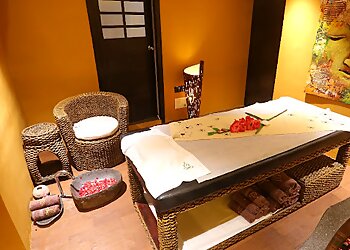Are Shiatsu Massages painful?


Shiatsu is a type of Japanese handwork based on pseudoscience concepts from traditional Chinese medicine including the notion of energy pathways running throughout the body. Being popularized in the late twentieth century by Tokujiro Namikoshi, shiatsu has been around in some form or another since the beginning of China. Japanese warriors of the samurai believed that the flow or Qi' of energy through the body was key to winning battles. The energy believed to be similar to 'life force' that circulated through and throughout the body. Shiatsu massage was designed to aid in physical movements and to aid in the recovery of injuries for warriors.
Modern Shiatsu massage is a contemporary version of Shiatsu. Modern shiatsu is a fundamental hand therapy that focuses on pressure points on the hands, elbows and shoulders. According to the American Heritage Dictionary, shiatsu is "a method of treatment which aims to restore health using various methods" (Webster's Collegiate Dictionary). Shiatsu is a combination Western and Eastern medicine, with an emphasis on the holistic health benefits of therapeutic touch.
Shiatsu can bring many benefits to those who use it. Shiatsu can be utilized to treat various ailments by both children and adults. Shiatsu massages can ease tension and stress from a variety of sources. The most common is the back muscles getting aching from sitting for long periods of time. Others who can benefit from this therapy include pregnant women who have cramps, bloating, or urinary issues athletes who must focus on their performance and not worry about bloating or urinary problems and those recovering from injuries sustained in sports.
Shiatsu is typically practiced in a fully clothed setting. This is to ensure that the client and practitioner are comfortable in a relaxed and natural state of consciousness. Some practitioners prefer wearing gloves to accomplish this objective. Others don't. For the purposes of this article, practitioners aren't expected to wear anything more than a looser, cotton shirt. Shiatsu is not a therapy in the sense of. It is a form of therapeutic touch that is designed to ease tension in muscles, relieving mental and emotional tension, relieving tightness in the muscles, and enhancing the quality of life.
The aim of a shiatsu therapist is to help their client relax by applying gentle pressure to specific points of the body. The areas selected may be those related to the major organ systems (omach, liver, lungs and so on. ) or any other part that is connected to the major organs in terms of function (such as muscles, joints and tendons, for example. .
Shiatsu massage can include identifying and isolating certain channels (pressure points) where energy can flow. These pressure points may then be treated using different techniques, ranging from gentle pressure to powerful compression. The goal is to relieve certain conditions such as migraines, headaches and cramps, dizziness or chronic pain.
Shiatsu is now gaining popularity in the west as a complementary therapy which means that it is used in combination with or as a substitute of traditional Western medicine. Although shiatsu therapists are trained professionals, there are many self-trained, home-based therapists available. Many people are becoming familiar with Eastern healing and its practices and are using these sources for information and treatment. Many believe that shiatsu therapies can bring balance to the mind and body, promote energy, reduce stress, encourage healing and alleviate symptoms of illness and disease, and help restore good health.
There are many different ways that an therapist could offer the Shiatsu massage. 서울출장마사지 Therapists can provide a Shiatsu massage in the client's home, the privacy of a public or private location, or in an institution for nursing, a hospital or any other healthcare facility depending on the client's needs. There aren't any rules that say a therapist has to offer this treatment in an established or clinical setting, so patients can receive treatment in their own home. This flexibility gives patients the opportunity to set his or her own boundaries in terms of discomfort and pain.
